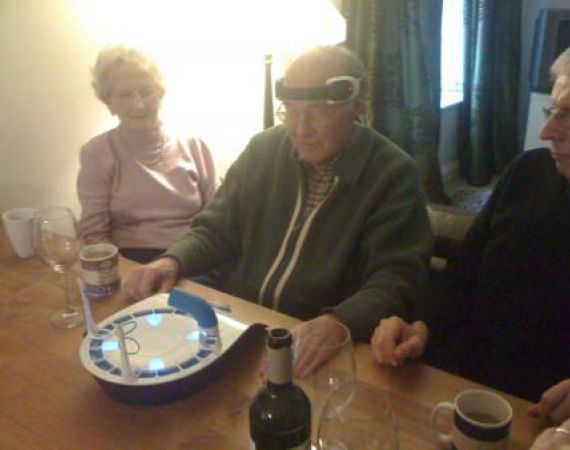Posted on Sat 13 Mar 2010
More human than human – Brain computer interfaces
Is it possible to upload or download instructions to the brain? We are getting closer. Christie Nicholson of Scientific American started her talk on brain computer interfaces with the obligatory William Gibson and Matrix references and then went on to give a comprehensive and fascinating history of…

My Grandad playing Mindflex
Posted by

Clare Reddington
Clare is the CEO of Watershed and a Visiting Professor at University of the West of England.Is it possible to upload or download instructions to the brain? We are getting closer.
Christie Nicholson of Scientific American started her talk on brain computer interfaces with the obligatory William Gibson and Matrix references and then went on to give a comprehensive and fascinating history of the research so far and what might be possible.
Starting with reality: the brain is electric - everything we think and feel starts off with an electrical impulse moving though our neurons. The brain is malleable - significant functional and structural changes occur throughout our lifetime. Research in the last ten years have shown that the brain can adapt and rewire itself.
There is 100 billion neurons is the human brain network and researchers have found a way to record electrical impulses, decode them and
translate them into something a computer will understand. So far this has mostly been done with monkeys (it usually is), controlling robotic arms and even feeding themselves. The amazing things is that the monkeys develop a kinaesthetic relationship with the robotic arm.
Most of the human research has been done with patients who suffer from locked in syndrome. Matt Nagle is one of the first human cyborgs who was paralysed from the neck down after being stabbed. He had a chipped embedded into his brain which allows him to control objects and play computer games. This is done with an intracortical electrode, a chip embedded right into the grey matter. In 5 – 10 years, this may allow people to feed themselves and even stand up. The holy grail is picking up a glass of water with a robotic arm - although achieving a closed feedback loop of sensation is the tricky bit – otherwise the glass will be smashed.
It also gets more complicated when we reverse the process and enable machines to input data to the brain.
Some crazy, future-facing stuff:
DARPA's Silent Talk research – making telepathic soldiers by installing an EEG inside helmets to enable word-less communication on the battlefield.
Optogenetics (Stanford University) - researchers have taken a gene from pond scum bacteria and injected it into a mouse’s brain, reactions can then be triggered using different coloured lights. A kind of on/off switch. This might have therapeutic benefits for people suffering from depression and narcolepsy. See the Wired article on this.
Blue brain (Lausanne, Switzerland) - Mapping a rat brain like the human genome project. Now moving on to humans.
OpenEEG (contributed from the floor - making plans and software for
do-it-yourself EEG devices available for free.
The session largely avoided the ethics (which would have been huge) but concentrated on the possibilities. I played Mindflex over Christmas (see family photo). Its not brilliant when you are drunk, but even a simple plastic board game you can buy on Amazon is pretty amazing when you are controlling it with your brain.